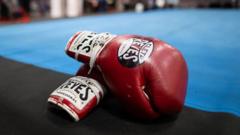Are Stricter Safety Rules in Japan Enough to Prevent Tragedies?

Stricter Measures in Japanese Boxing Following Tragic Deaths
The world of boxing has always been a high-stakes arena, both physically and emotionally. Recently, it has been rocked by tragedy as Japanese boxing officials have voted to implement stricter rules on weight loss and introduce urine tests following the deaths of two promising fighters. This pivotal decision comes after the heartbreaking loss of Shigetoshi Kotari and Hiromasa Urakawa, both aged 28, who succumbed to injuries sustained during bouts on the same card in Tokyo on August 2. The boxing community is now grappling with the implications of these changes and the overall safety of fighters.
The Context of the Tragedy
On that fateful night at Tokyo's Korakuen Hall, both boxers underwent surgery for subdural hematoma—a serious condition where blood accumulates between the skull and the brain. This shocking incident has sparked calls for immediate action to enhance the safety protocols within the sport. The Japan Boxing Commission (JBC) has taken these calls seriously, paving the way for significant changes in how boxing is regulated in the country.
New Safety Measures Implemented
In response to the tragic events, the JBC announced that all Oriental and Pacific Boxing Federation (OPBF) title bouts will now be limited to 10 rounds instead of the traditional 12. This adjustment is aimed at reducing the physical toll on fighters, particularly in high-pressure situations like title matches. Additionally, the Japanese Professional Boxing Association (JPBA), the JBC, and gym owners convened to discuss further emergency measures, resulting in a unanimous vote for implementing urine tests to monitor dehydration levels.
Ambulance Availability and Emergency Support
Another critical amendment is the requirement for ambulances to be present at all boxing events, even those not classified as world title bouts. This measure ensures immediate medical assistance can be provided in the event of an emergency. Furthermore, hospitals will collaborate with boxing governing bodies to be prepared for emergency surgeries related to head and other severe injuries. This proactive approach reflects a growing awareness of the inherent risks associated with the sport.
Revised Training Guidelines
In addition to addressing immediate health concerns, the JBC has also established new guidelines regarding training. Fighters will now be required to adhere to specific regulations concerning how long they must stop sparring before a fight. This measure aims to minimize the risk of injuries during intense training sessions, ensuring fighters are in optimal condition on the day of the match.
A Commitment to Fighter Safety
Tsuyoshi Yasukochi, secretary general of the JBC, emphasized the importance of these new measures. He stated, "Officials have decided to take all possible measures to ensure that the deaths of these two boxers are not in vain." This commitment to improving safety standards demonstrates a collective responsibility among officials, trainers, and fighters to prioritize health and well-being above all else.
Ongoing Investigations and Future Guidelines
To further enhance safety protocols, an accident investigation committee is set to investigate the causes of the boxers' deaths. This inquiry will be crucial in formulating updated guidelines aimed at preventing similar tragedies in the future. The JBC and JPBA are also planning to meet with medical professionals and representatives from the amateur boxing federation to discuss comprehensive strategies for fighter safety.
The Impact on the Boxing Community
The recent decisions have resonated throughout the boxing community. Fighters, trainers, and fans alike are reflecting on the importance of safety in a sport that is often characterized by its physical demands. The introduction of these new regulations signifies a pivotal moment in Japanese boxing, where the balance between competition and safety is being carefully reevaluated.
Changing the Culture of Boxing
To foster a culture that prioritizes the well-being of fighters, it is essential for all stakeholders, including promoters, trainers, and regulatory bodies, to work together. The implementation of these safety measures represents a necessary shift in how boxing is perceived and managed, especially in countries where the sport is deeply embedded in the culture.
Fostering Awareness Among Fighters
In light of these changes, educating fighters about the risks associated with weight cutting and dehydration is paramount. Many boxers engage in extreme weight loss practices to meet weight class requirements, often compromising their health in the process. Increased awareness about the dangers of rapid weight loss and the importance of staying hydrated can empower fighters to make safer choices during training and before fights.
The Role of Medical Professionals
Medical professionals play an integral role in enhancing fighter safety. Their expertise is invaluable in implementing and enforcing the new regulations. Regular health check-ups, pre-fight medical assessments, and ongoing monitoring of fighters' health can help prevent tragic events like those that occurred in August.
Long-Term Solutions for Fighter Safety
The recent changes in Japanese boxing regulations are just the beginning of a more extensive conversation about safety in combat sports. Long-term solutions may involve ongoing research into the effects of weight cutting, improvements in training practices, and the development of more comprehensive guidelines for fighter health and safety.
Encouraging Responsibility Among Promoters
Promoters also bear a significant responsibility in ensuring the safety of fighters. They must prioritize medical support at events and adhere to the newly established regulations. By fostering an environment where fighter safety is paramount, promoters can help cultivate a more positive culture within the sport.
FAQs
What are the new weight loss regulations in Japanese boxing?
The Japan Boxing Commission has introduced stricter rules regarding weight loss, including monitoring dehydration through urine tests and limiting title bouts to 10 rounds instead of 12.
Why are ambulances now required at boxing events?
Ambulances are now mandatory at all boxing events to ensure immediate medical assistance is available in case of emergencies, particularly for head injuries.
What is the accident investigation committee's role?
The accident investigation committee will analyze the causes of the recent deaths of boxers and work on updating safety guidelines to prevent similar incidents in the future.
Conclusion
The tragic deaths of Shigetoshi Kotari and Hiromasa Urakawa have served as a wake-up call for the boxing community in Japan. By implementing stricter regulations and fostering a culture of safety, officials hope to prevent further tragedies and protect the lives of fighters. As the sport evolves, it is crucial for all stakeholders to remain vigilant and committed to ensuring that safety takes precedence over competition. How can the boxing community continue to work together to enhance fighter safety in the future? #BoxingSafety #FighterHealth #JapaneseBoxing
Published: 2025-08-12 11:24:24 | Category: sport



